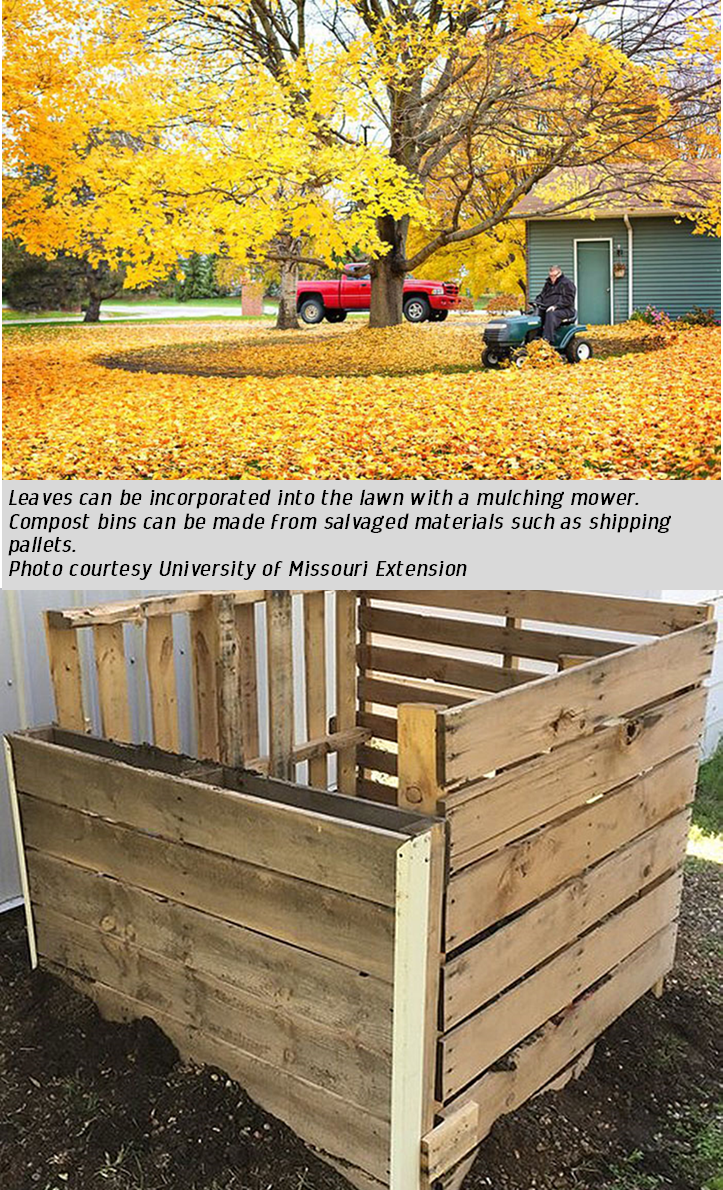|
|
Adapted from Missouri Environment and Gardening article by Dr. David Trinklein, University of Missouri Still have leaves to rake up? The vivid colors of autumn leaves were an attractive sight. However, once they fall and accumulate in the yard, leaves can become a problem. Dealing with autumn leaves can be labor-intensive and, at times, a frustrating task. Especially when leaves keep blowing into one's yard from neighboring homes, making the process seem never ending!
Proper use of fall leaves can maintain a healthy, attractive landscape. When allowed to accumulate over turfgrass and low ornamental plants, leaves can pack down and form a tight mat, particularly during the course of a wet winter. A thick layer of leaves can block sunlight from reaching turfgrass, thus reducing the ability of plants to manufacture food in the fall. Cool season turfgrass species such as Kentucky bluegrass or fescue need fall sunlight. On the other hand, fallen leaves represent a valuable resource that too many gardeners overlook. In addition to containing modest amounts of certain essential mineral elements (e.g., nitrogen, phosphorus and potassium), they are a rich source of organic matter. Organic matter helps build good soil structure. Bagging, burning, or discarding autumn leaves is not a sound decision from an ecological or economic point of view. One way to recycle autumn leaves is to mulch them into the lawn. When leaves are still damp, adjust your lawn mower to its highest setting and start mowing. By using a crisscross pattern and double-mowing, leaves often can be reduced to the size of confetti. So-called "mulching mowers" are especially proficient at shredding fallen leaves. The tiny pieces of leaves will gradually filter into the lawn and begin to decompose. The end result will be the release of nutrients for use by the turfgrass. Research has demonstrated that a layer of leaves up to six inches thick can be mulched into the lawn with no ill effects. Leaves can be incorporated into the lawn with a mulching mower. Composting is another way to turn leaves into a useful soil amendment. Compost is partially decomposed organic matter created by soil organisms that break down plant matter. Compost is beneficial for improving soil because it binds small soil particles together making them larger. This "aggregation" of soil particles helps improve aeration, root penetration and water movement. Compost bins can be made from salvaged materials such as shipping pallets. A backyard compost pile can be almost any size that is convenient for the space available. However, for best results, it should be no less than about 25 square feet in area at its base and three feet in height. As a rule, larger compost piles are better than smaller ones. Whatever the size, always locate a compost pile in an area that is well-drained. Find more information on composting in this MU Publication “Making and Using Compost”- https://extension.missouri.edu/publications/g6956 MU Extension is offering a free online compost webinar on December 16, 6-8pm. Register by calling 573-581-3231 or at this link https://web.cvent.com/event/41265a8f-f564-4de2-9281-c5ee5b3e81b0/regProcessStep1 Autumn leaves can also be made into leaf mold. This is an organic material consisting of partially decomposed leaves. Unlike traditional compost that undergoes a heat-generating, bacterially-driven process, leaf mold is produced through a cooler and much slower fungal-driven process. Leaf mold is made much the same way as compost, only no additional nitrogen is added. The resulting partially decomposed material is an excellent additive to soil. It can be mixed in during tillage, or used as a surface mulch for weed control. In addition to mulching leaves into the lawn or turning them into compost or leaf mold, they can be used as a mulch to protect tender plants (e.g., azaleas and rhododendrons) in the landscape. The best leaves for this use are those are very stiff and do not collapse (form a dense mat) during wet weather. Oak leaves are excellent for use as winter mulch. When used as mulch, leaves should be enclosed in a wire cylinder placed around the plant to keep them in place. Have more gardening questions? Contact Master Gardeners of Greater Kansas City Hotline 816-833-TREE(8733) or email [email protected] Presented by Cathy Bylinowski, Horticulture Instructor, [email protected] Comments are closed.
|
Categories
All
Archives
July 2024
|
Grain Valley NewsGrain Valley News is a free community news source published weekly online. |
Contact Us |



 RSS Feed
RSS Feed
